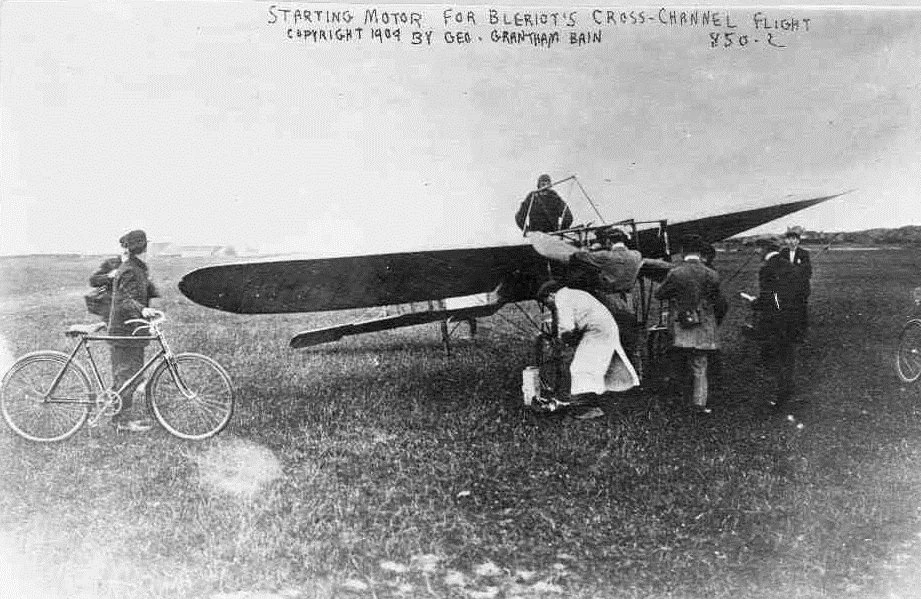On a hazy summer morning in 1909, a lone monoplane soared over the white cliffs of Dover, trailing a roar that startled grazing sheep and sent onlookers scrambling toward the coastline. At the controls was a mustachioed French engineer named Louis Blériot, whose daring flight across the English Channel etched his name into aviation history. Blériot's achievement, flying 35.4 kilometers, (22 miles) from Calais to Dover in 37 minutes, marked not only a personal triumph but a milestone in humankind's conquest of the skies.
Terry Bailey explains.
Starting the engine prior to the crossing.
A boyhood shaped by invention
Louis Blériot was born on the 1st of July, 1872, in Cambrai, a town nestled in northern France. His father, Clémence Blériot, was a prosperous manufacturer, and young Louis was given an excellent education. He demonstrated a keen interest in engineering from an early age, constructing toy boats and tinkering with mechanical devices. After completing his studies at the prestigious École Centrale Paris, Blériot worked in the electric lighting business and became a successful inventor, patenting the first practical headlamp for automobiles, an innovation that earned him considerable wealth.
However, electricity and automobiles, while fascinating, couldn't match the allure of flight. Like many others captivated by the exploits of pioneers like Otto Lilienthal and the powered flights of the Wright brothers, Blériot became obsessed with the dream of powered aviation. He began investing his time and fortune in designing and building flying machines, many of which ended in crashes, disappointment, and lessons learned the hard way.
The long road to the channel
Blériot's early attempts at flight were fraught with failure. Between 1900 and 1908, he constructed a variety of gliders, ornithopters, and powered aircraft with names like the Blériot I through Blériot VIII. Most were unstable, underpowered, or mechanically unreliable. Still, his persistence was unwavering. Working with the brilliant engineer Raymond Saulnier, Blériot refined his designs until he produced a breakthrough: the Blériot XI.
The Blériot XI was a revolutionary aircraft for its time. A monoplane with a tractor configuration (the propeller at the front), it had a wooden frame covered in fabric, a 25-horsepower Anzani engine, and bicycle wheels for landing gear. Its simplicity, light weight, and maneuverability made it superior to many of the Wright brothers' inspired aeroplanes. On the 25th of July, 1909, Blériot would stake everything on this machine.
Channel challenge
The English Channel had long symbolized natural and political division, a waterway that had thwarted would-be conquerors from Napoleon to Hitler. However, to early aviators, it represented something more: a daring challenge and a test of the aircraft's reliability, pilot skill, and human courage.
Newspaper magnate Lord Northcliffe, publisher of the Daily Mail, offered a £1,000 prize (about £120,000 in today's money) to the first aviator who could fly across the Channel from France to England. Several tried, but one, Hubert Latham, was even poised to win until an engine failure plunged him into the sea.
Blériot seized the opportunity, at dawn on the 25th of July, 1909, with a bandaged foot from a previous crash, he took off from Les Barraques near Calais. He had no compass, and the weather was overcast. Guided only by instinct and glimpses of the English coastline, he flew at altitudes varying between 250 and 1,000 feet, enduring winds, vibration, and the ever-present risk of mechanical failure. As he neared the English shore, he spotted the chalk cliffs of Dover and descended toward the designated landing site near Dover Castle.
A flight that changed everything
Blériot's landing was less than graceful, he broke a propeller blade and damaged a landing gear strut, but he had succeeded. The flight took 37 minutes, and the world took notice. Crowds rushed to greet him, cheering him as a hero. King Edward VII sent congratulations, and the feat was celebrated in newspapers across the globe. The military implications were not lost on observers, particularly in Britain, where some newspapers warned, "England is no longer an island."
Blériot's Channel crossing was more than a publicity stunt. It was a clear signal that powered flight had arrived, not just as a novelty, but as a practical and transformative mode of transportation. It spurred interest in aviation across Europe and North America, inspired new generations of aircraft builders, and helped lay the foundation for modern aerospace engineering.
After the crossing.
A legacy in the skies
After his Channel triumph, Louis Blériot became a household name. He capitalized on his fame by founding the Blériot Aéronautique company, producing aircraft for civilian and military customers. His factory became one of the largest and most respected in pre-war France. During World War I, Blériot's designs played a key role in training pilots and conducting reconnaissance missions.
Blériot continued to promote aviation throughout his life, but he never undertook another flight as iconic as his journey across the Channel. He died in Paris on the 1st of August, 1936 at the age of 64, but his legacy endures. The Blériot XI that he flew that day now rests in the Musée des Arts et Métiers in Paris, a silent witness to the courage and innovation that helped usher in the age of flight.
In today's world of supersonic jets and space travel, it's easy to overlook the audacity of that moment in 1909. Yet, Louis Blériot's journey across the English Channel remains one of aviation's most compelling tales, a testament to human ingenuity and the timeless urge to conquer the impossible.
Louis Blériot's flight across the English Channel in 1909 stands as one of the great inflection points in the history of aviation, a moment when dreams gave way to possibility, and possibility transformed into reality. His journey was not just a triumph of machinery and engineering, but of resilience, vision, and the indomitable human spirit. From the workshops of northern France to the windswept cliffs of Dover, Blériot's life traced the arc of invention against a backdrop of skepticism, risk, and relentless trial.
Blériot's achievement symbolized far more than the successful crossing of a geographical barrier. It shattered the illusion of natural frontiers and awakened the world to a new age, one in which flight was no longer bound to the pages of fantasy or the cautious experiments of isolated inventors. His monoplane, fragile by today's standards, became the vessel through which the modern world first glimpsed the potential of powered flight to connect nations, reshape warfare, and redefine what it meant to explore.
The legacy of that 37-minute flight reverberated through the 20th century and beyond. It inspired the early aviation industry, influenced military strategy, and encouraged a generation of pioneers who would take flight higher, faster, and farther. Blériot's crossing was a catalyst, one that propelled aviation from curiosity to cornerstone, from daring to indispensable.
When looking back on that hazy morning over a century ago, it is done so with the understanding that Louis Blériot's courage helped lift humanity off the ground, literally and figuratively. The flight was the first wingbeat in a world that would soon stretch skyward and, eventually, toward the stars.
The site has been offering a wide variety of high-quality, free history content since 2012. If you’d like to say ‘thank you’ and help us with site running costs, please consider donating here.
Notes:
Ornithopter
An ornithopter is a type of flying machine that achieves flight by mimicking the flapping wing motion of birds, bats, or insects. The term comes from the Greek words ornithos, (ὄρνιθος), (bird) and pteron, (πτερόν), (wing). Unlike conventional aircraft, which use fixed wings and thrust-producing engines or propellers, ornithopters rely on oscillating or flapping wings to generate both lift and propulsion. This method of flight is inspired by nature and is known as biomimetic engineering, where the designs are modelled after living organisms.
The concept of the ornithopter dates back centuries. One of the earliest known designs appears in the notebooks of Leonardo da Vinci, who sketched several flying machines based on the idea of human-powered flapping wings. However, due to the limitations of human muscle strength and materials available at the time, none of these early concepts were able to achieve practical flight. It wasn't until the development of lightweight materials and miniature motors in the 20th and 21st centuries that small, functioning ornithopters became feasible.
Modern ornithopters range from small remote-controlled models used in research or hobby flying to experimental drones to surveillance devices. Some are powered by tiny electric motors and are capable of highly agile flight, similar to birds or insects. Engineers and scientists continue to study ornithopters to better understand natural flight and to develop innovative solutions for aircraft in environments where traditional fixed-wing or rotary systems are less effective, such as in confined or turbulent spaces. Though they are not yet widely used for commercial applications, ornithopters hold promise in the fields of robotics, aeronautics, and even space exploration.








